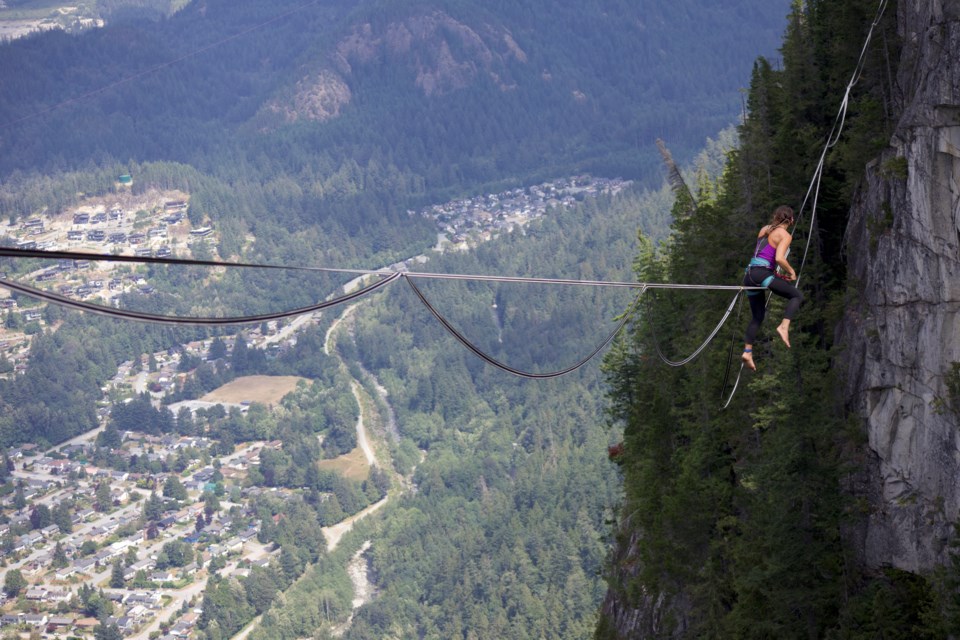As I stand at the edge of a north-facing gully on the Stawamus Chief walking paracord along the edge, my heart jumps into my throat. At a dizzying height of 700 metres above the Howe Sound, death welcomes me into its cold embrace if I take one wrong step. The granite is slanting more than I’d like, and my approach shoes aren’t gripping well with recent rainfall. Paracord gets stuck around a scraggly tree, and my fellow highliner loosens it for us, his back facing the nothingness of a gap we walk while highlining.
Highlining is an inherently dangerous sport that can cause injury or even death. People often say things like “you’re crazy,” or, “I could never do that,” when they hear about or see the sport. But I’d like to take a moment of your day to declare my defence of dangerous deeds. With the Sea to Sky as my audience, perhaps my column this week is preaching to the choir. You can’t trundle a rock in this corridor without coming across someone doing something both seemingly death-defying and deeply meaningful to them.
Despite this fact, I’ll continue my sermon on the granite mound.
My first line of defence for danger comes from the fact there is no such thing as a world or a life that is perpetually safe. I walk out of my house in the morning and come across speeding cars as I cross the street, and while I take precautions to mitigate the risk of getting hit by a car, I can’t control the actions of drivers on the road. Despite this risk, I happily go about my day, and no one calls me crazy for walking across a crosswalk.
But maybe this isn’t a strong enough example. Skiing or snowboarding entails whipping yourself down a steep slope at speeds humans generally attain whilst in a solid metal box. Trees and sharkies pose danger, and then there’s people who don’t follow the alpine responsibility code.
What walking, skiing or even rock climbing have in common is power in numbers. Enough people take part in these activities that they’re normalized. They come with standardized rules and expectations borne out of innumerable individuals who experimented with brilliant schemes and ticking timebombs, trailblazing paths for us to follow and making rules for the game so we can learn from their fall lines.
Highlining also has trailblazers, mentors and best practices, but we lack sheer numbers to reach volume for normalization. While the sport is growing, with new faces practically each time I go out to rig and walk, I’m unsure if it will ever saturate the same way as other activities—because it’s arguably more terrifying.
You have to get comfortable with your parasympathetic nervous system telling you you’re about to die when in actuality, you’re safe, so long as your gear is in good shape and you’re using it correctly.
On top of being terrifying and dangerous, it’s gruelling. I’ve met few folks who can stand up on a highline immediately, let alone walk, and you need to want to pursue the sport to really get good. I’ve learned more about myself in the last four years in this arguably pointless pursuit than I have at any other stage of my life. It humbles and uplifts me every single time.
To achieve basic abilities in this individualistic pastime, you must stand on the shoulders of giants, though understanding Newton’s laws of motion also helps.
Bonds are forged when you learn to conquer your fears with fellow athletes, just as those who walked before you did. I have learned to literally trust someone with my life, to question my abilities and always ask for advice, because you can’t fake it ‘till you make it when your error can lead to your own or your friend’s death.
It’s a kind of trust you just can’t get from going for a cup of coffee or a beer with a new acquaintance, though offering someone an alpine start cup of joe or a trail snack is always good form.
Learning from others, mastering yourself, having a positive attitude and moving your body are all worthwhile pastimes, and I think paradoxically pursuing danger lends itself to fulfilling the three higher needs of humans as defined by Maslow.
My physiological and safety needs are fulfilled, but love and belonging, esteem and self-actualization are fortified by pursuing a sport that, at the end of the day, does little for the world but means more than anything to me.
Thanks, danger.




